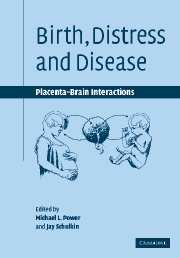Book contents
- Frontmatter
- Contents
- List of contributors
- Preface
- Introduction: brain and placenta, birth and behavior, health and disease
- 1 Placental expression of neurohormones and other neuroactive molecules in human pregnancy
- 2 The regulation of human parturition
- 3 Maternal nutrition and metabolic control of pregnancy
- 4 Fetal HPA activation, preterm birth and postnatal programming
- 5 Prenatal glucocorticoids and the programming of adult disease
- 6 Prenatal stress and stress physiology influences human fetal and infant development
- 7 Glucocorticoids and the ups and downs of neuropeptide gene expression
- 8 Glucocorticoid facilitation of corticotropin-releasing hormone in the placenta and the brain: functional impact on birth and behavior
- Index
2 - The regulation of human parturition
Published online by Cambridge University Press: 16 October 2009
- Frontmatter
- Contents
- List of contributors
- Preface
- Introduction: brain and placenta, birth and behavior, health and disease
- 1 Placental expression of neurohormones and other neuroactive molecules in human pregnancy
- 2 The regulation of human parturition
- 3 Maternal nutrition and metabolic control of pregnancy
- 4 Fetal HPA activation, preterm birth and postnatal programming
- 5 Prenatal glucocorticoids and the programming of adult disease
- 6 Prenatal stress and stress physiology influences human fetal and infant development
- 7 Glucocorticoids and the ups and downs of neuropeptide gene expression
- 8 Glucocorticoid facilitation of corticotropin-releasing hormone in the placenta and the brain: functional impact on birth and behavior
- Index
Summary
Preterm birth accounts for 70% of neonatal mortality and is a common cause for intellectual handicap among survivors. Approximately 50% of cases of cerebral palsy are associated with preterm birth, in turn preterm birth increases the risk of cerebral palsy by 40 times! (Goldenberg, 2002). Preterm labor thus afflicts individuals at the very beginning of their lives, depriving them of opportunities and increasing health and educational costs for families and society in general. Unfortunately the rates of preterm birth have not changed for over 30 years due to an inability to predict the event and lack of effective therapies.
This clinical problem has driven research into the mechanisms that regulate the timing of human birth and the disorders which cause preterm birth.
For reasons of ethics most research in the past has focused on animal work, especially in the sheep. Unfortunately studies have revealed substantial differences between parturition in humans and that in other animals. Thus animal studies provide us with clues as to how systems operate to regulate delivery in mammals but frustrate us with uncertainty as to whether particular mechanisms operate in the human. Experimental in vivo studies provide the strongest evidence for cause and effect, yet the closer we come to the human state in our near relatives the apes, the larger the ethical constraints on experimental studies become.
- Type
- Chapter
- Information
- Birth, Distress and DiseasePlacental-Brain Interactions, pp. 74 - 87Publisher: Cambridge University PressPrint publication year: 2005
- 5
- Cited by

